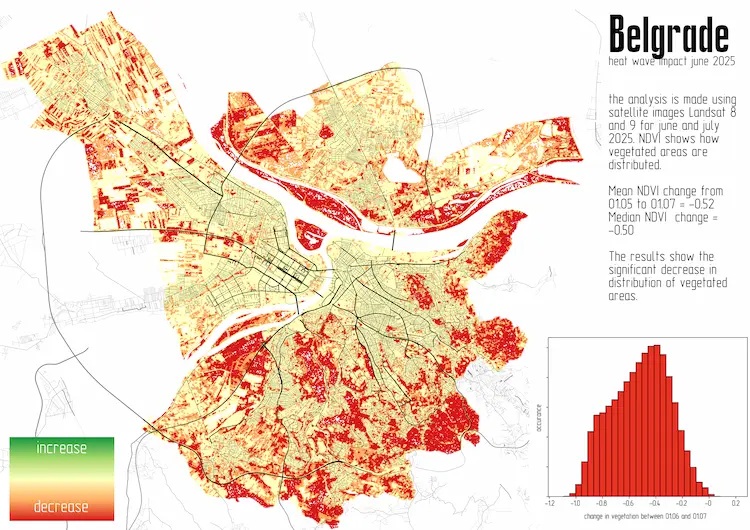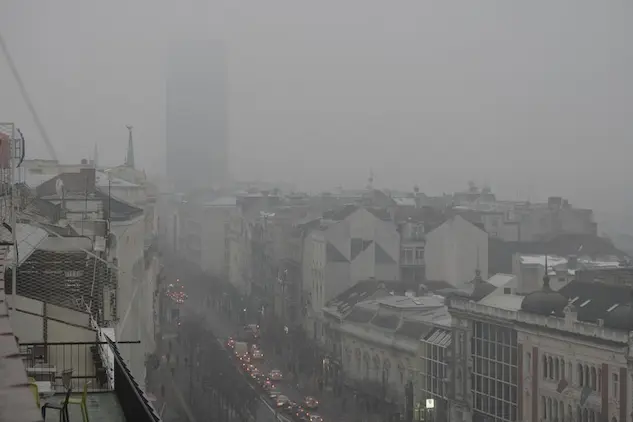In June 2025, Belgrade faced one of the harshest heatwaves in recent memory. According to monthly bulletin for Serbia 2025, this june was the warmest June on record, with the average air temperature exceeding the 1990–2020 norm by +3.2 ºC.
From above, the damage was unmistakable. Satellite data revealed a striking shift: Belgrade’s green cover had withered dramatically in just a few weeks. Urban vegetation is not just a natural asset -it’s critical infrastructure. It cools the air, supports mental and physical health, protects business continuity during heatwaves, and boosts the resilience of urban economies facing climate shocks.
Methodology
To assess the impact of the June 2025 heatwave on Belgrade’s vegetation cover, time series of satellite imagery from Landsat 8 and 9 were analyzed, available through the USGS Earth Explorer.
For each image, the Normalized Difference Vegetation Index (NDVI) was calculated, a widely used remote sensing metric that reflects the health and density of vegetation. NDVI values range from -1 to +1, with higher values indicating lush, active vegetation. The scenes were resampled and clipped to Belgrade’s boundaries using QGIS, and NDVI was calculated on a 30×30 meter grid.
To measure change, the pixel-by-pixel difference in NDVI between the beginning and end of June 2025 was calculated. These values were aggregated to compute city-wide statistics: a mean NDVI drop of 0.52 and a median change of -0.50, both pointing to significant deterioration in vegetative health.
Only a handful of urban plots maintained stable NDVI values. In almost all areas – residential, industrial, and peri-urban – the vegetation stress was evident. The resulting NDVI map highlights the spatial footprint of damage and zones of resilience.
Heat impact on Belgrade’s green cover: findings & interpretation
The NDVI change analysis reveals a city-wide decline in vegetative health during June 2025. While all areas were affected, the severity and pattern of degradation varied across neighborhoods. For a detailed view of these differences, see the NDVI change map below, which illustrates the spatial distribution of vegetation loss across the city.

Urban parks and forests, such as Košutnjak and Zvezdara, showed significant NDVI drops, suggesting early signs of drought stress even in dense tree cover. Residential areas, especially in New Belgrade and Voždovac, experienced a patchy decline, likely reflecting differences in yard vegetation. The most dramatic declines, often exceeding -0.7 NDVI points, were found in industrial zones and construction sites, where vegetation was already sparse and vulnerable.
Interestingly, some riverside plots and irrigated gardens showed stability – revealing how water access shields pockets of Belgrade’s green cover. These patterns underscore the fragility of Belgrade’s green cover under extreme heat, and the uneven resilience of different urban ecosystems. Public greenery, often relied upon for temperature regulation, shade, and biodiversity, appears especially vulnerable.
Read more about the importance of urban green spaces here.
Why it matters
Vegetation is not merely aesthetic, it is critical infrastructure. In cities like Belgrade, green cover serves as a natural buffer against extreme heat, reduces air pollution, manages stormwater, and supports mental and physical well-being. Its degradation is not just an environmental issue but a public health concern and an economic risk.
- For local businesses, the loss of urban greenery can translate into decreased foot traffic in overheated neighborhoods, increased cooling costs, and reduced productivity in poorly adapted buildings;
- For governments and developers, it raises urgent questions about how to plan and invest in resilient infrastructure.
This case from Belgrade shows how a single hot month can destabilize green systems. Cities must treat this as a warning. They need to measure what matters and adapt planning to a warmer, more volatile climate. Belgrade’s green cover must become a strategic asset, not a luxury. Cities should rethink zoning rules and invest in irrigation infrastructure. They must protect mature trees and expand vegetation across all urban surfaces. This includes rooftops, facades, parking lots, and schoolyards. Climate resilience depends not only on engineering but on living systems. When cities ignore vegetation, they expose people to rising climate risks.
Read more about the 2024 heatwave in Belgrade here.


